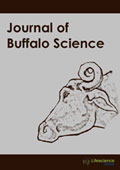jbs
Editor’s Choice : Water Buffalo (Bubalus bubalis) and their Technological Advantages for the Design in Healthy Meat Product
|
|
Abstract: Current trends in the formulation for new food shows that healthy or “functional” products are gradually increasing their participation in the preference of the consumers (Catalá Ramón). Nowadays, the participation of meat products in this behavior of the marketing is not growing at the same rate, because their ingredients and nutritional compounds, like saturated fats, which are rejected by consumers. But, a group of investigators from La Salle University (Universidad De La Salle, Bogotá, Colombia), have been working hard, in order to obtain healthier meat products, using Bufalo as the main raw material, because its important properties like 15 to 35% of protein, 40% more water holding capacity (CRA, in Spanish) and 30% more emulsifying capacity (CE in Spanish). Previous values are compared with raw beef. The group, who has developed a functional buffalo meat product, added vegetal oil from soybeans and dehydrated hemoglobin to its formulation and obtained a food with 70% less of saturated fat and a significantly increase of iron, without affecting the non-saturated fat compound of the food. Now, a functional product packed in a “smart packaging” has been studied, in order to increase its shelf life, supported on positive migration process. Keywords: Buffalo, Meat Products, Healthy products, La salle University.Download Full Article |
Editor’s Choice : Effect of Royal Jelly on the Fertilizing Ability of Buffalo Spermatozoa In Vitro
|
|
Abstract: The aim of the present study was to assess the effect of addition of Royal jelly in presence of heparin on buffalo (Bubalus Bubalis) sperm motility, acrosome reaction and in vitro fertilization (IVF) of buffalo oocytes. Frozen buffalo spermatozoa from five bulls were thawed and motile fraction was obtained by swim up technique. The spermatozoa were washed, treated with100 µg/ml heparin, and then exposed to 0.4% Royal Jelly (RJ) for 3 h. Sperm motility, acrosomal integrity and fertilization rate of matured oocytes were assessed at 1, 2 and 3 h. The percentages of sperm motility, intact acrosome and fertilization rate of matured oocytes were higher (P<0.05) in 0.4% RJ compared to that in the control. After 2 h of incubation the percentage of motility, intact acrosome of spermatozoa and fertilization rate of matured oocytes, respectively, were 93.6 %, 77.6% and 72.6% in 0.4% RJ. These results suggest that treating buffalo sperm with 0.4% RJ in combination with heparin is effective not only to induce sperm acrosome reaction but also is effective for in vitro fertilizing capacity of the cryopreserved buffalo spermatozoa. Keywords: Buffalo, Capacitation, Spermatozoa, IVF, Royal Jelly.Download Full Article |
Editor’s Choice : Single Nucleotide Polymorphisms Detected and In Silico Analysis of the 5’ Flanking Sequence and Exon 1 in the Bubalus bubalis Leptin Gene
|
|
Abstract: The leptin plays a critical role in the regulation of reproductive and immune function in humans, it is at the centre of the complex networks that coordinate changes in nutritional state with many diverse aspects of mammalian biology. In this study, we have sequenced the 5’ flanking region and exon 1 of the leptin gene in buffalo, and have detected eight single nucleotide polymorphisms; we have made evidence, through in silico analysis that many of them fall within putative binding sites for transcription factors. Starting from the bovine whole genome shotgun sequence, that encodes the complete sequence of the leptin gene, we had designed primers to amplify two amplicons, so to cover the 5’ flanking and exon 1 of the leptin gene of 41 non related buffaloes. The newly sequenced buffalo fragment was submitted to profile search for transcription factor binding sites, using the MATCHTM program, focusing on the areas where the single nucleotide polymorphisms had been detected. Our analysis shows that the majority of the identified single nucleotide polymorphisms fall into the core sequence of transcription factor binding sites that regulate the expression of target genes in many physiological processes within mammalian tissues. Because the leptin gene plays an important role in influencing economic traits in cattle, the novel detected single nucleotide polymorphisms might be used in association studies to assess their potential of being genetic markers for selection. Keywords: Genetic markers, promoter,transcription factor binding sites.Download Full Article |
Editor’s Choice : Analysis of Genetic Diversity of Indian Buffalo Breeds by DNA Markers
|
|
Abstract: Buffalo is an important species contributing significantly to Indian economy. There is urgent need to study genetic diversity between and within breeds using appropriate set of microsatellite markers which can be further supplemented by using Genome sequencing data, phonemics and high density arrays. Animal resources are valuable assets of a country. Present buffalo breeds have gene pools of wide representation and valuable combination of genes. Genetic variability also provides the opportunity for tracing the history of populations, species, and their ancestors through DNA based markers. For the overall breed improvement and to meet future challenges there is an urgent need to characterize buffalo breeds. It is our responsibility to conserve, preserve and maintain the animal genetic diversity. Keywords: Genetic diversity, buffalo bread, DNA markers.Download Full Article |






















